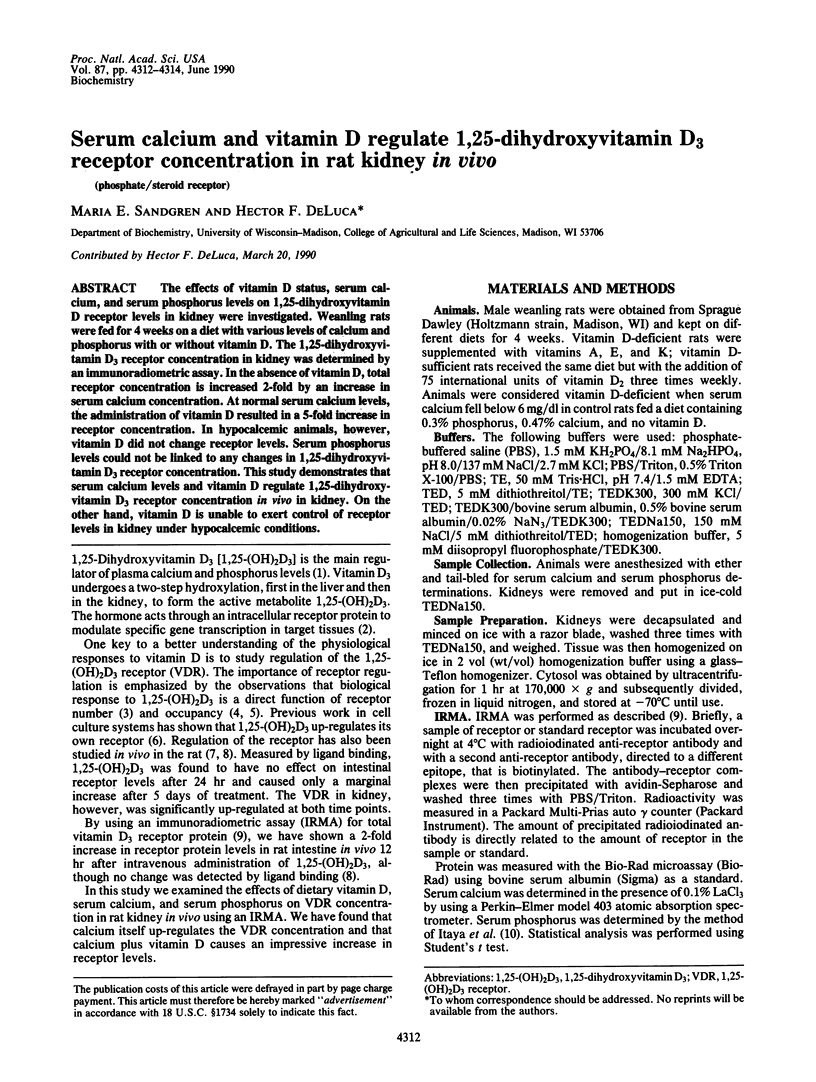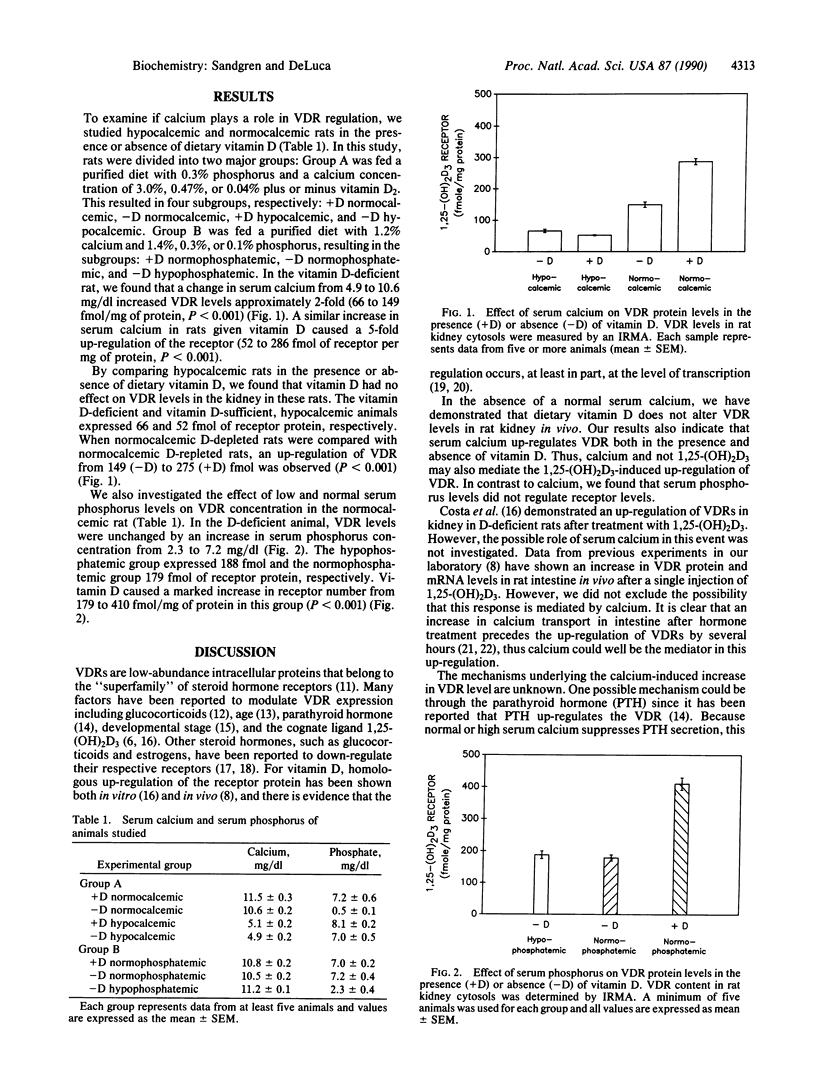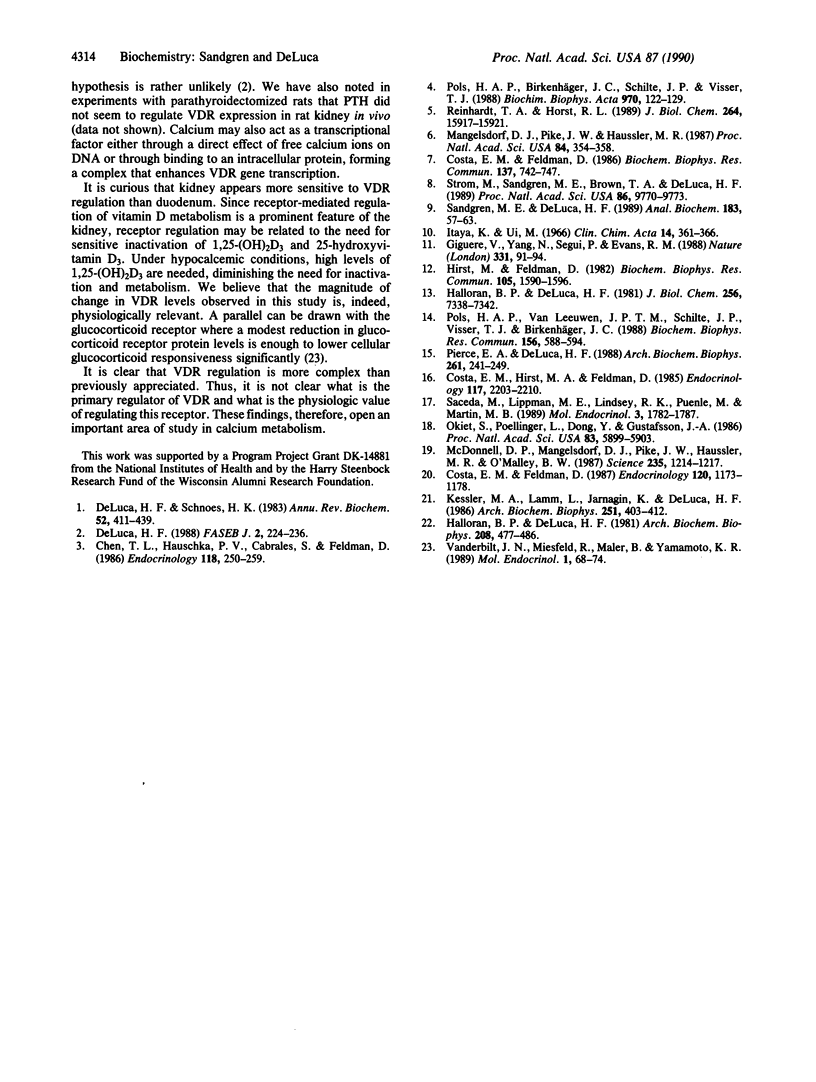Abstract
The effects of vitamin D status, serum calcium, and serum phosphorus levels on 1,25-dihydroxyvitamin D receptor levels in kidney were investigated. Weanling rats were fed for 4 weeks on a diet with various levels of calcium and phosphorus with or without vitamin D. The 1,25-dihydroxyvitamin D3 receptor concentration in kidney was determined by an immunoradiometric assay. In the absence of vitamin D, total receptor concentration is increased 2-fold by an increase in serum calcium concentration. At normal serum calcium levels, the administration of vitamin D resulted in a 5-fold increase in receptor concentration. In hypocalcemic animals, however, vitamin D did not change receptor levels. Serum phosphorus levels could not be linked to any changes in 1,25-dihydroxyvitamin D3 receptor concentration. This study demonstrates that serum calcium levels and vitamin D regulate 1,25-dihydroxyvitamin D3 receptor concentration in vivo in kidney. On the other hand, vitamin D is unable to exert control of receptor levels in kidney under hypocalcemic conditions.
Full text
PDF


Selected References
These references are in PubMed. This may not be the complete list of references from this article.
- Chen T. L., Hauschka P. V., Cabrales S., Feldman D. The effects of 1,25-dihydroxyvitamin D3 and dexamethasone on rat osteoblast-like primary cell cultures: receptor occupancy and functional expression patterns for three different bioresponses. Endocrinology. 1986 Jan;118(1):250–259. doi: 10.1210/endo-118-1-250. [DOI] [PubMed] [Google Scholar]
- Costa E. M., Feldman D. Homologous up-regulation of the 1,25 (OH)2 vitamin D3 receptor in rats. Biochem Biophys Res Commun. 1986 Jun 13;137(2):742–747. doi: 10.1016/0006-291x(86)91141-1. [DOI] [PubMed] [Google Scholar]
- Costa E. M., Feldman D. Measurement of 1,25-dihydroxyvitamin D3 receptor turnover by dense amino acid labeling: changes during receptor up-regulation by vitamin D metabolites. Endocrinology. 1987 Mar;120(3):1173–1178. doi: 10.1210/endo-120-3-1173. [DOI] [PubMed] [Google Scholar]
- Costa E. M., Hirst M. A., Feldman D. Regulation of 1,25-dihydroxyvitamin D3 receptors by vitamin D analogs in cultured mammalian cells. Endocrinology. 1985 Nov;117(5):2203–2210. doi: 10.1210/endo-117-5-2203. [DOI] [PubMed] [Google Scholar]
- DeLuca H. F., Schnoes H. K. Vitamin D: recent advances. Annu Rev Biochem. 1983;52:411–439. doi: 10.1146/annurev.bi.52.070183.002211. [DOI] [PubMed] [Google Scholar]
- DeLuca H. F. The vitamin D story: a collaborative effort of basic science and clinical medicine. FASEB J. 1988 Mar 1;2(3):224–236. [PubMed] [Google Scholar]
- Giguère V., Yang N., Segui P., Evans R. M. Identification of a new class of steroid hormone receptors. Nature. 1988 Jan 7;331(6151):91–94. doi: 10.1038/331091a0. [DOI] [PubMed] [Google Scholar]
- Halloran B. P., De Luca H. F. Intestinal calcium transport: evidence for two distinct mechanisms of action of 1,25-dihydroxyvitamin D3. Arch Biochem Biophys. 1981 May;208(2):477–486. doi: 10.1016/0003-9861(81)90534-8. [DOI] [PubMed] [Google Scholar]
- Halloran B. P., DeLuca H. F. Appearance of the intestinal cytosolic receptor for 1,25-dihydroxyvitamin D3 during neonatal development in the rat. J Biol Chem. 1981 Jul 25;256(14):7338–7342. [PubMed] [Google Scholar]
- Hirst M., Feldman D. Glucocorticoids down-regulate the number of 1, 25-dihydroxyvitamin D3 receptors in mouse intestine. Biochem Biophys Res Commun. 1982 Apr 29;105(4):1590–1596. doi: 10.1016/0006-291x(82)90970-6. [DOI] [PubMed] [Google Scholar]
- Itaya K., Ui M. A new micromethod for the colorimetric determination of inorganic phosphate. Clin Chim Acta. 1966 Sep;14(3):361–366. doi: 10.1016/0009-8981(66)90114-8. [DOI] [PubMed] [Google Scholar]
- Kessler M. A., Lamm L., Jarnagin K., DeLuca H. F. 1,25-Dihydroxyvitamin D3-stimulated mRNAs in rat small intestine. Arch Biochem Biophys. 1986 Dec;251(2):403–412. doi: 10.1016/0003-9861(86)90346-2. [DOI] [PubMed] [Google Scholar]
- Mangelsdorf D. J., Pike J. W., Haussler M. R. Avian and mammalian receptors for 1,25-dihydroxyvitamin D3: in vitro translation to characterize size and hormone-dependent regulation. Proc Natl Acad Sci U S A. 1987 Jan;84(2):354–358. doi: 10.1073/pnas.84.2.354. [DOI] [PMC free article] [PubMed] [Google Scholar]
- McDonnell D. P., Mangelsdorf D. J., Pike J. W., Haussler M. R., O'Malley B. W. Molecular cloning of complementary DNA encoding the avian receptor for vitamin D. Science. 1987 Mar 6;235(4793):1214–1217. doi: 10.1126/science.3029866. [DOI] [PubMed] [Google Scholar]
- Okret S., Poellinger L., Dong Y., Gustafsson J. A. Down-regulation of glucocorticoid receptor mRNA by glucocorticoid hormones and recognition by the receptor of a specific binding sequence within a receptor cDNA clone. Proc Natl Acad Sci U S A. 1986 Aug;83(16):5899–5903. doi: 10.1073/pnas.83.16.5899. [DOI] [PMC free article] [PubMed] [Google Scholar]
- Pierce E. A., DeLuca H. F. Regulation of the intestinal 1,25-dihydroxyvitamin D3 receptor during neonatal development in the rat. Arch Biochem Biophys. 1988 Mar;261(2):241–249. doi: 10.1016/0003-9861(88)90338-4. [DOI] [PubMed] [Google Scholar]
- Pols H. A., Birkenhäger J. C., Schilte J. P., Visser T. J. Evidence that the self-induced metabolism of 1,25-dihydroxyvitamin D-3 limits the homologous up-regulation of its receptor in rat osteosarcoma cells. Biochim Biophys Acta. 1988 Jun 30;970(2):122–129. doi: 10.1016/0167-4889(88)90170-x. [DOI] [PubMed] [Google Scholar]
- Pols H. A., van Leeuwen J. P., Schilte J. P., Visser T. J., Birkenhäger J. C. Heterologous up-regulation of the 1,25-dihydroxyvitamin D3 receptor by parathyroid hormone (PTH) and PTH-like peptide in osteoblast-like cells. Biochem Biophys Res Commun. 1988 Oct 14;156(1):588–594. doi: 10.1016/s0006-291x(88)80883-0. [DOI] [PubMed] [Google Scholar]
- Reinhardt T. A., Horst R. L. Self-induction of 1,25-dihydroxyvitamin D3 metabolism limits receptor occupancy and target tissue responsiveness. J Biol Chem. 1989 Sep 25;264(27):15917–15921. [PubMed] [Google Scholar]
- Saceda M., Lippman M. E., Lindsey R. K., Puente M., Martin M. B. Role of an estrogen receptor-dependent mechanism in the regulation of estrogen receptor mRNA in MCF-7 cells. Mol Endocrinol. 1989 Nov;3(11):1782–1787. doi: 10.1210/mend-3-11-1782. [DOI] [PubMed] [Google Scholar]
- Sandgren M. E., Deluca H. F. An immunoradiometric assay for 1,25-dihydroxyvitamin D3 receptor. Anal Biochem. 1989 Nov 15;183(1):57–63. doi: 10.1016/0003-2697(89)90171-1. [DOI] [PubMed] [Google Scholar]
- Strom M., Sandgren M. E., Brown T. A., DeLuca H. F. 1,25-Dihydroxyvitamin D3 up-regulates the 1,25-dihydroxyvitamin D3 receptor in vivo. Proc Natl Acad Sci U S A. 1989 Dec;86(24):9770–9773. doi: 10.1073/pnas.86.24.9770. [DOI] [PMC free article] [PubMed] [Google Scholar]
- Vanderbilt J. N., Miesfeld R., Maler B. A., Yamamoto K. R. Intracellular receptor concentration limits glucocorticoid-dependent enhancer activity. Mol Endocrinol. 1987 Jan;1(1):68–74. doi: 10.1210/mend-1-1-68. [DOI] [PubMed] [Google Scholar]


